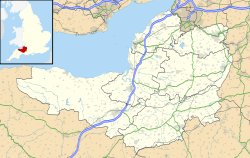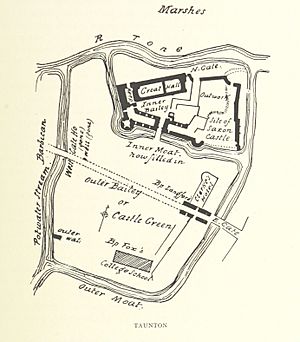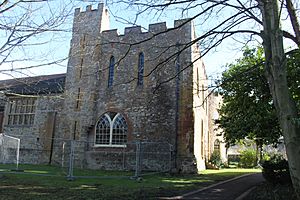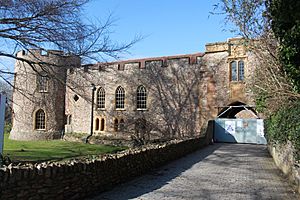Taunton Castle facts for kids
Quick facts for kids Taunton Castle |
|
|---|---|
| Taunton, Somerset | |

Taunton Castle
|
|
|
Shown within Somerset
|
|
| Coordinates | 51°00′57″N 3°06′17″W / 51.0158°N 3.1046°W |
| Type | Norman |
| Site history | |
| Built | 1129 |
| Built by | William Giffard |
| Materials | Stone |
| Official name | Taunton Castle: a motte and bailey castle, part of the outer bailey, an Anglo-Saxon cemetery and a Civil War artillery platform |
| Designated | 25 July 1923 |
| Reference no. | 1013541 |
Taunton Castle is an old castle located in Taunton, Somerset, England. It was built to protect the town. The castle's history goes way back to the Anglo-Saxon period. Later, a priory (a type of religious house) was on the site.
The Normans then built a strong stone castle. This castle belonged to the Bishops of Winchester. Today, the main parts of the castle have been rebuilt. They now house the Museum of Somerset and the Somerset Military Museum. In 1952, the building was named a Grade I listed building, which means it's a very important historical site.
Contents
Early Beginnings: Anglo-Saxon Times
The first defenses in Taunton were started around 710 AD. King Ine of Wessex and Queen Æthelburg of Wessex built them. However, this early fort was destroyed just twelve years later. It's not likely it was on the exact spot of the current castle.
A church, called a minster, was later founded in Taunton. Queen Frithugyth, wife of King Æthelheard of Wessex, is said to have started it. The Bishops of Wessex also built a large house next to it.
Medieval and Tudor Periods
When the Domesday Book was written, Taunton belonged to the Bishop of Winchester. There was a minster or Augustinian Priory on the site. Between 1107 and 1129, William Giffard changed the bishop's hall into a castle. He was an important official for King Henry I of England.
In 1216, Bishop Peter des Roches defended the castle. He was loyal to King John during a rebellion by barons. By the late 1100s, the castle's main tower, called a keep, was quite large. It had a big hall on the first floor. During the Second Barons' War, the castle was used as a prison. The son of Simon de Montfort was held there until 1282.
In 1451, the Earl of Devon attacked the castle. It was defended by Lord Bonville. At that time, the castle had two main courtyards, called baileys.
The entrance gate to the inner part of the castle was likely built around the time of Edward I of England (1239–1307). Bishop Walter Langton changed it in 1496. He added a large window and placed his family's coat of arms above it. The Royal Coat of King Henry VII of England was placed below.
The Great Hall is a very large room inside the castle. It is about 120 feet long. Its walls seem to be partly Norman, but they have been changed a lot over time. Bishop Langton added Tudor windows. Most of these have since been replaced. The last building put up inside the castle walls was a schoolhouse. Bishop Richard Foxe paid for it in the 1520s.
Civil War and Later Events
By 1600, Taunton Castle was falling apart. But it was repaired during the English Civil War. In June 1644, the Parliamentarian army took Taunton. This made it the only place they controlled in the South West.
After the Parliamentarian army lost a battle in Cornwall, the Royalists began to besiege Taunton. From July 1644 to July 1645, Parliamentarian forces were trapped inside. Colonel Robert Blake led the defense. The Royalist forces were led by Lord Goring. The town was briefly helped by Sir William Waller in November. Another relief group arrived in May, but the siege continued. Finally, more help came on June 14, after the Battle of Naseby.
In 1685, a famous event called the Bloody Assizes happened in the Great Hall. Judge Jeffreys held trials there. This was after the Monmouth Rebellion, when people rebelled against King James II. More than 500 supporters of James Monmouth were brought to court. Many were punished severely to show what happens to those who go against the king.
Castle Design and Changes
Taunton Castle was a typical Norman keep from the 1100s. It was about 50 feet long and 40 feet wide. It had three levels, and its walls were about 13 feet thick. This keep was built into the walls of an inner area. There was also an outer bailey, which is now called "Castle Green." The castle was used as a prison until the late 1600s.
By 1780, much of the castle was in poor condition. Sir Benjamin Hammet, a banker and Member of Parliament for Taunton, paid for repairs. He rebuilt parts of it in a Georgian style. He added a new roof and many windows. During the 1700s and 1800s, the Great Hall was used for public meetings.
Today, two hotels stand where the outer part of the castle used to be. They have decorative battlements to match the old castle. The main gate leading into the castle area is partly original. It has arches from the time of Edward I of England. The upper part was rebuilt in 1816.
In 1873, the Somerset Archaeological and Natural History Society bought the castle. Between 1899 and 1900, the Great Hall was repaired. It became their main museum space. A library was added in 1908-9 to hold the society's growing book collection.
Taunton Castle Today
The Great Hall and the inner part of the castle are now home to the Museum of Somerset. It reopened in September 2011 after a big renovation. This project cost £7 million.
Castle House, a 17th-century building, is also an Ancient Monument. It needed repairs and was listed on the Heritage at Risk Register. It has been repaired but is still empty as of 2013.
Images for kids









